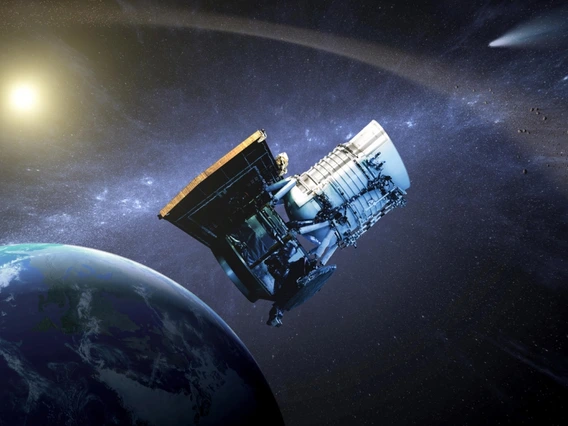LPL Newsletter for July 2021
Thursday, July 1, 2021
LPL has a long history and extensive expertise with small-body observations and research. Programs like Catalina Sky Survey and SPACEWATCH® have been successful in finding and characterizing near-Earth objects (NEOs), those that come within 30 million miles of Earth's orbit, that could pose a danger to our planet. Now, NASA has given the go-ahead to a new tool for hunting NEOs: the NEO Surveyor infrared space telescope, led by Professor Amy Mainzer. Thanks to its eight infrared camera detectors, NEO Surveyor will be able to do what Earth-based telescopes can't—search for NEOs by sensing their heat emissions. This ability to search in the infrared will allow for discovery of NEOs that are faint in visibile wavelengths and will also allow for computation of object size. And NASA has just approved a two-year extension for NEOWISE, also led by Professor Mainzer. NEOWISE has already discovered more than 30,000 previously unknown asteroids, including 338 near-Earth asteroids and 34 comets.
PTYS undergraduate minor David Cantillo is first-author of a study that suggests asteroid 16 Psyche, the target of an upcoming NASA mission, may not be as metallic as previously thought. Scientists are interested in 16 Psyche because, based on its metallic content and density, it could be the iron core of a planet that failed to form in the early days of the solar system. If Cantillo's estimates of lower metallicity and bulk density are correct, 16 Psyche could instead be a rubble-pile asteroid, similar to asteroid Bennu, recently visited by NASA's OSIRIS-REx mission.
Using atomic-resolution sample analysis and a new framework relying on quantum mechanics and thermodynamics, Professor Tom Zega and his team have analyzed a grain from a sample of the Allende meteorite to trace its journey from the beginning of the solar system and understand the environmental conditions that shaped its formation. As with any good mystery, some of the results from the analysis didn't fit with current theories, so Zega's team designed models to simulate the chemical processes that samples would be subjected to in a protoplanetary disk. Check out the article below to learn more about the particle's composition, how it became part of an asteroid that broke apart and fell to Earth, and what it reveals about planetary formation.
Contact us at PG4gdWVycz0iem52eWdiOkhOWUNZQHljeS5uZXZtYmFuLnJxaCI+SE5ZQ1lAeWN5Lm5ldm1iYW4ucnFoPC9uPg== if you'd like to be added to newsletter or event distributions.

LPL Will Lead Mission to Discover Potentially Dangerous Asteroids
NASA has tasked LPL Professor Amy Mainzer, an expert in infrared astronomy, with leading NEO Surveyor, a mission to find, track and characterize yet unseen asteroids and comets that may pose a threat to Earth.

NASA Extends LPL-led Asteroid Search Mission
For two more years, NASA's Near-Earth Object Wide-field Infrared Survey Explorer, or NEOWISE, will continue its hunt for asteroids and comets – including objects that could pose a hazard to Earth.

Asteroid 16 Pysche Might Not Be What Scientists Expected
New research led by PTYS undergraduate minor student David Cantillo finds that the target asteroid of NASA's Psyche mission may not be as metallic or dense as previously predicted.

Researchers Trace Dust Grain's Journey through Newborn Solar System
Combining atomic-scale sample analysis and models simulating likely conditions in the nascent solar system, a new study led by LPL Professor Tom Zega reveals clues about the origin of crystals formed more than 4.5 billion years ago.

